大英博物馆中英文简介(2)
- 格式:docx
- 大小:11.47 KB
- 文档页数:6
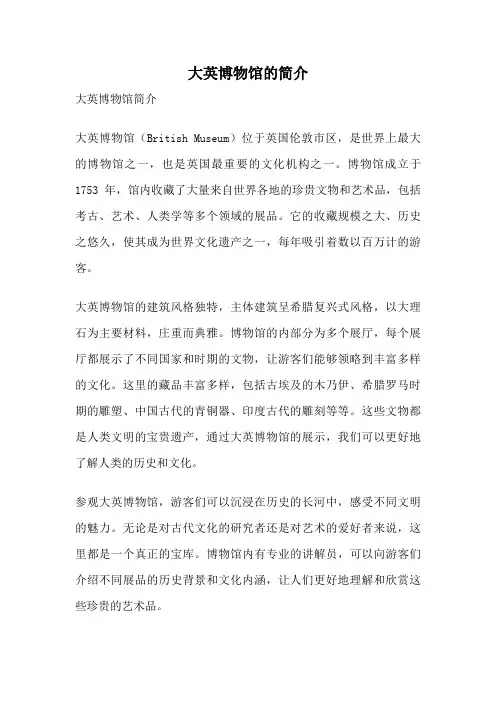
大英博物馆的简介大英博物馆简介大英博物馆(British Museum)位于英国伦敦市区,是世界上最大的博物馆之一,也是英国最重要的文化机构之一。
博物馆成立于1753年,馆内收藏了大量来自世界各地的珍贵文物和艺术品,包括考古、艺术、人类学等多个领域的展品。
它的收藏规模之大、历史之悠久,使其成为世界文化遗产之一,每年吸引着数以百万计的游客。
大英博物馆的建筑风格独特,主体建筑呈希腊复兴式风格,以大理石为主要材料,庄重而典雅。
博物馆的内部分为多个展厅,每个展厅都展示了不同国家和时期的文物,让游客们能够领略到丰富多样的文化。
这里的藏品丰富多样,包括古埃及的木乃伊、希腊罗马时期的雕塑、中国古代的青铜器、印度古代的雕刻等等。
这些文物都是人类文明的宝贵遗产,通过大英博物馆的展示,我们可以更好地了解人类的历史和文化。
参观大英博物馆,游客们可以沉浸在历史的长河中,感受不同文明的魅力。
无论是对古代文化的研究者还是对艺术的爱好者来说,这里都是一个真正的宝库。
博物馆内有专业的讲解员,可以向游客们介绍不同展品的历史背景和文化内涵,让人们更好地理解和欣赏这些珍贵的艺术品。
大英博物馆还举办各种临时展览和教育活动,为广大的观众带来更多的文化体验。
这些展览和活动涵盖了各个领域,包括艺术、历史、考古等等,为游客们提供了更多的学习和参与的机会。
大英博物馆的开放时间相对较长,每天都对公众开放,而且入场是免费的,所以吸引了大量的游客。
这也使得大英博物馆成为了伦敦最受欢迎的旅游景点之一。
无论是当地居民还是国外游客,都能够在这里找到自己感兴趣的展品,领略到不同文化的魅力。
大英博物馆是一个汇集了世界各地珍贵文物的宝库,通过它的展示,我们可以更好地了解和欣赏人类的历史和文化。
无论是对历史感兴趣的人还是对艺术追求的人,这里都是一个不可错过的地方。
让我们一起来探索大英博物馆,领略人类文明的壮丽之处。
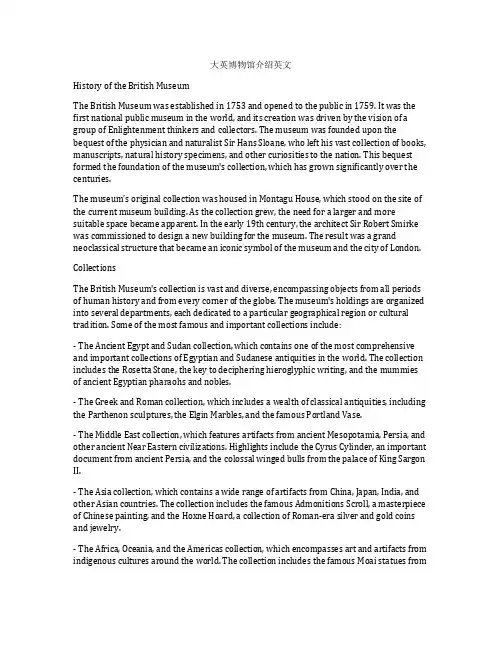
大英博物馆介绍英文History of the British MuseumThe British Museum was established in 1753 and opened to the public in 1759. It was the first national public museum in the world, and its creation was driven by the vision of a group of Enlightenment thinkers and collectors. The museum was founded upon the bequest of the physician and naturalist Sir Hans Sloane, who left his vast collection of books, manuscripts, natural history specimens, and other curiosities to the nation. This bequest formed the foundation of the museum's collection, which has grown significantly over the centuries.The museum’s original collection was housed in Montagu House, which stood on the site of the current museum building. As the collection grew, the need for a larger and more suitable space became apparent. In the early 19th century, the architect Sir Robert Smirke was commissioned to design a new building for the museum. The result was a grand neoclassical structure that became an iconic symbol of the museum and the city of London.CollectionsThe British Museum's collection is vast and diverse, encompassing objects from all periods of human history and from every corner of the globe. The museum's holdings are organized into several departments, each dedicated to a particular geographical region or cultural tradition. Some of the most famous and important collections include:- The Ancient Egypt and Sudan collection, which contains one of the most comprehensive and important collections of Egyptian and Sudanese antiquities in the world. The collection includes the Rosetta Stone, the key to deciphering hieroglyphic writing, and the mummies of ancient Egyptian pharaohs and nobles.- The Greek and Roman collection, which includes a wealth of classical antiquities, including the Parthenon sculptures, the Elgin Marbles, and the famous Portland Vase.- The Middle East collection, which features artifacts from ancient Mesopotamia, Persia, and other ancient Near Eastern civilizations. Highlights include the Cyrus Cylinder, an important document from ancient Persia, and the colossal winged bulls from the palace of King Sargon II.- The Asia collection, which contains a wide range of artifacts from China, Japan, India, and other Asian countries. The collection includes the famous Admonitions Scroll, a masterpiece of Chinese painting, and the Hoxne Hoard, a collection of Roman-era silver and gold coins and jewelry.- The Africa, Oceania, and the Americas collection, which encompasses art and artifacts from indigenous cultures around the world. The collection includes the famous Moai statues fromEaster Island, as well as a wide range of objects from the indigenous peoples of Africa, the Pacific, and the Americas.In addition to these main collections, the museum also houses extensive holdings of prints, drawings, coins, medals, and other works on paper, as well as a library and archive that contains a wealth of scholarly resources for researchers and scholars.Significance and InfluenceThe British Museum's collection is not only vast and impressive but also holds immense significance in the world of culture, archaeology, and academia. The museum's collection is an invaluable resource for scholars, researchers, and students, providing a rich and diverse source of material for the study of human history and culture. The museum's curators and researchers are engaged in ongoing scholarly study and publication, making important contributions to our understanding of the world's cultural heritage.In addition to its scholarly contributions, the British Museum plays an important role in public education and engagement. The museum hosts a wide range of public programs, including lectures, workshops, and special events, aimed at sharing the museum's collection with the public and fostering an appreciation for world history and culture. The museum also maintains a strong online presence, with a website that features virtual tours, educational resources, and digital access to the museum's collection.Furthermore, the British Museum serves as a leading voice in the discussion of cultural heritage and preservation. The museum has been involved in numerous international initiatives aimed at the protection of cultural heritage in conflict zones, as well as the repatriation of cultural objects to their countries of origin. The museum's extensive holdings and its commitment to ethical curatorial practices have made it a model for other cultural institutions around the world.ConclusionThe British Museum is a truly remarkable institution, with a collection that spans the entirety of human history and culture. Its vast and diverse holdings make it an invaluable resource for scholars, researchers, and students, as well as an important center for public education and engagement. The museum's commitment to ethical curatorial practices and its role in the international discourse on cultural heritage make it a leader in the world of cultural institutions. The British Museum stands as a testament to the enduring significance of human history and culture and its importance in the modern world.。
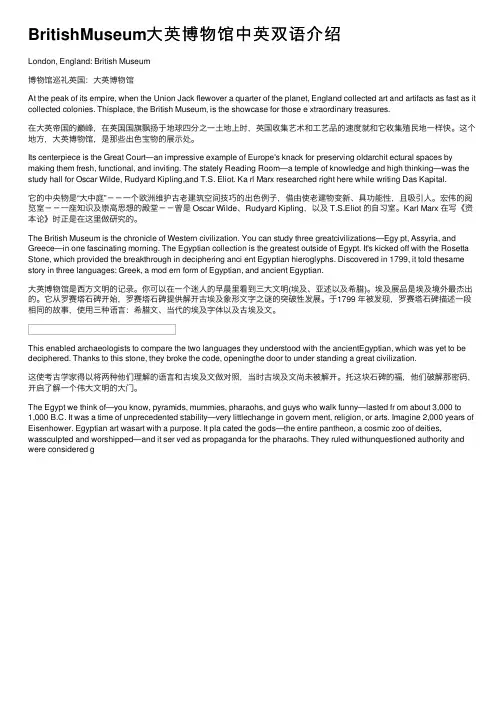
BritishMuseum⼤英博物馆中英双语介绍London, England: British Museum博物馆巡礼英国:⼤英博物馆At the peak of its empire, when the Union Jack flewover a quarter of the planet, England collected art and artifacts as fast as it collected colonies. Thisplace, the British Museum, is the showcase for those e xtraordinary treasures.在⼤英帝国的巅峰,在英国国旗飘扬于地球四分之⼀⼟地上时,英国收集艺术和⼯艺品的速度就和它收集殖民地⼀样快。
这个地⽅,⼤英博物馆,是那些出⾊宝物的展⽰处。
Its centerpiece is the Great Court—an impressive example of Europe's knack for preserving oldarchit ectural spaces by making them fresh, functional, and inviting. The stately Reading Room—a temple of knowledge and high thinking—was the study hall for Oscar Wilde, Rudyard Kipling,and T.S. Eliot. Ka rl Marx researched right here while writing Das Kapital.它的中央物是“⼤中庭”--⼀个欧洲维护古⽼建筑空间技巧的出⾊例⼦,借由使⽼建物变新、具功能性,且吸引⼈。
宏伟的阅览室--⼀座知识及崇⾼思想的殿堂--曾是 Oscar Wilde、Rudyard Kipling,以及 T.S.Eliot 的⾃习室。
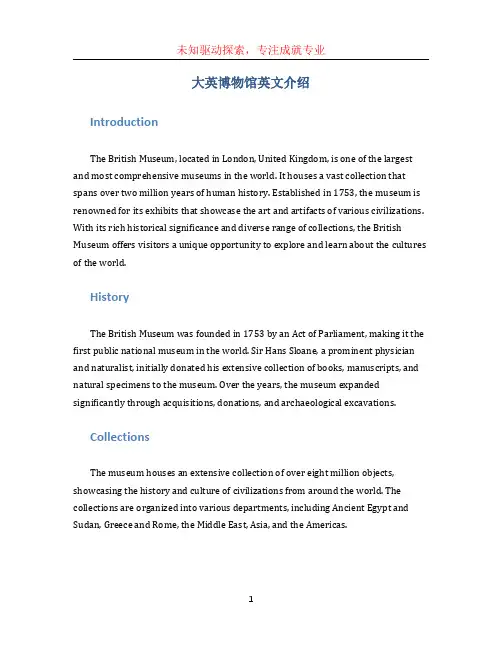
大英博物馆英文介绍IntroductionThe British Museum, located in London, United Kingdom, is one of the largest and most comprehensive museums in the world. It houses a vast collection that spans over two million years of human history. Established in 1753, the museum is renowned for its exhibits that showcase the art and artifacts of various civilizations. With its rich historical significance and diverse range of collections, the British Museum offers visitors a unique opportunity to explore and learn about the cultures of the world.HistoryThe British Museum was founded in 1753 by an Act of Parliament, making it the first public national museum in the world. Sir Hans Sloane, a prominent physician and naturalist, initially donated his extensive collection of books, manuscripts, and natural specimens to the museum. Over the years, the museum expanded significantly through acquisitions, donations, and archaeological excavations.CollectionsThe museum houses an extensive collection of over eight million objects, showcasing the history and culture of civilizations from around the world. The collections are organized into various departments, including Ancient Egypt and Sudan, Greece and Rome, the Middle East, Asia, and the Americas.Ancient Egypt and SudanThe Egyptian collection in the British Museum is one of the most renowned in the world, featuring iconic artifacts such as the Rosetta Stone and the mummies of pharaohs. These artifacts provide insights into the religious beliefs, daily life, and funerary practices of the ancient Egyptians.Greece and RomeThe Greek and Roman collection at the museum is representative of the classical world. It includes sculptures, jewelry, pottery, and mosaics that showcase the artistic achievements of these ancient civilizations.The Middle EastThe Middle East department encompasses artifacts from ancient Mesopotamia, Persia, and the Islamic world. The collection includes cuneiform tablets, ancient jewelry, and intricate Islamic art.AsiaThe Asian collection at the British Museum covers a wide range of cultures, including Chinese, Japanese, Indian, and Southeast Asian civilizations. It houses exquisite ceramics, scrolls, textiles, and sculptures that reflect the rich artistic traditions of these regions.The AmericasThe museum also has a collection dedicated to the indigenous cultures of the Americas, including the Aztecs, Mayans, and Incas. It features intricate carvings, textiles, and gold ornaments from these civilizations.Exhibitions and EventsIn addition to its permanent collections, the British Museum regularly hosts temporary exhibitions and events that focus on specific themes or time periods. These exhibitions provide a deeper exploration of various aspects of human history and cultural diversity. The museum also offers educational programs, lectures, and workshops for visitors of all ages.Digital AccessIn an effort to make its collections more accessible to a global audience, the British Museum has developed an extensive digital platform. The museum’s website offers virtual tours, online exhibitions, and educational resources that allow visitors to explore the collections remotely. Through these digital initiatives, the museum aims to engage and inspire people from all over the world.Visiting InformationThe British Museum is located in the Bloomsbury area of London, easily accessible by public transport. The museum is open daily, except on selected holidays. Admission to the museum is free, although special exhibitions may have an entrance fee. The museum offers guided tours, audio guides, and information desks to assist visitors in navigating the vast collections.ConclusionThe British Museum is a treasure trove of human history and culture, offering a captivating journey through time. With its world-renowned artifacts and comprehensive collections, the museum provides a unique opportunity for visitors to explore and appreciate the rich heritage of civilizations from around the world.Whether you are an art enthusiast, a history buff, or simply curious about the past, a visit to the British Museum is a truly unforgettable experience.Note: This document is written in Markdown format and can be easily converted to HTML or other formats using appropriate tools.。
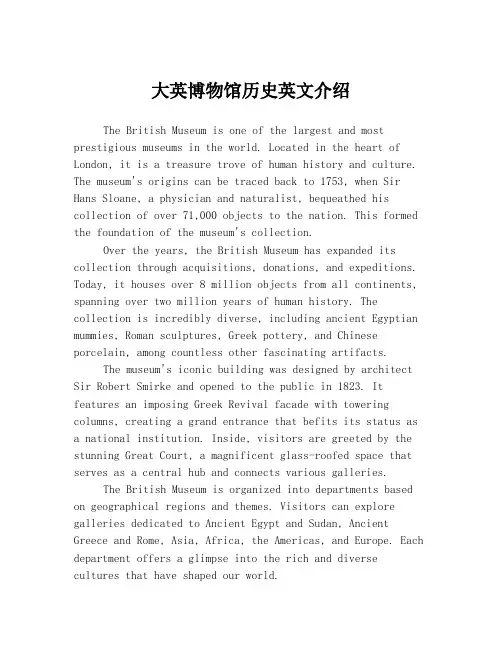
大英博物馆历史英文介绍The British Museum is one of the largest and most prestigious museums in the world. Located in the heart of London, it is a treasure trove of human history and culture. The museum's origins can be traced back to 1753, when Sir Hans Sloane, a physician and naturalist, bequeathed his collection of over 71,000 objects to the nation. This formed the foundation of the museum's collection.Over the years, the British Museum has expanded its collection through acquisitions, donations, and expeditions. Today, it houses over 8 million objects from all continents, spanning over two million years of human history. The collection is incredibly diverse, including ancient Egyptian mummies, Roman sculptures, Greek pottery, and Chinese porcelain, among countless other fascinating artifacts.The museum's iconic building was designed by architect Sir Robert Smirke and opened to the public in 1823. It features an imposing Greek Revival facade with towering columns, creating a grand entrance that befits its status as a national institution. Inside, visitors are greeted by the stunning Great Court, a magnificent glass-roofed space that serves as a central hub and connects various galleries.The British Museum is organized into departments based on geographical regions and themes. Visitors can explore galleries dedicated to Ancient Egypt and Sudan, Ancient Greece and Rome, Asia, Africa, the Americas, and Europe. Each department offers a glimpse into the rich and diversecultures that have shaped our world.In addition to its permanent collection, the British Museum hosts a wide range of temporary exhibitions, lectures, and events, providing visitors with new insights and perspectives on different aspects of human history and culture. There are also educational programs and resources available for schools and families, ensuring that visitors of all ages can engage with the museum's collections.A visit to the British Museum is a journey through time and across continents. It offers a unique opportunity to explore the wonders of human creativity and civilization, and gain a deeper understanding of the world we live in. As a symbol of cultural heritage and knowledge, the British Museum continues to inspire and educate millions of visitors each year.。
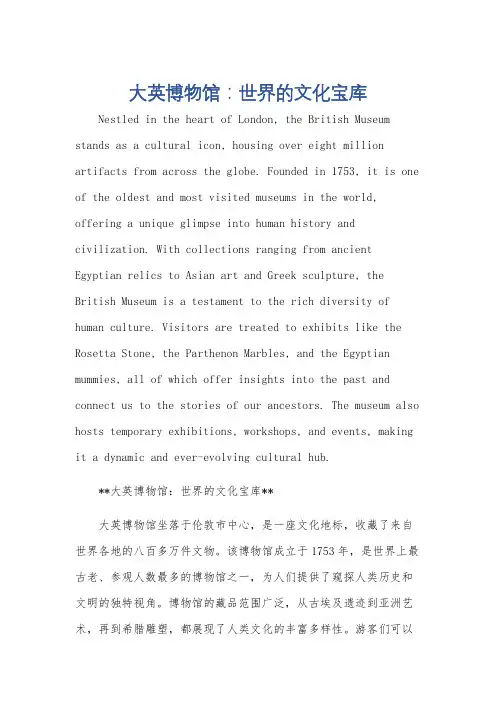
大英博物馆:世界的文化宝库Nestled in the heart of London, the British Museum stands as a cultural icon, housing over eight million artifacts from across the globe. Founded in 1753, it is one of the oldest and most visited museums in the world, offering a unique glimpse into human history and civilization. With collections ranging from ancient Egyptian relics to Asian art and Greek sculpture, the British Museum is a testament to the rich diversity of human culture. Visitors are treated to exhibits like the Rosetta Stone, the Parthenon Marbles, and the Egyptian mummies, all of which offer insights into the past and connect us to the stories of our ancestors. The museum also hosts temporary exhibitions, workshops, and events, making it a dynamic and ever-evolving cultural hub.**大英博物馆:世界的文化宝库**大英博物馆坐落于伦敦市中心,是一座文化地标,收藏了来自世界各地的八百多万件文物。
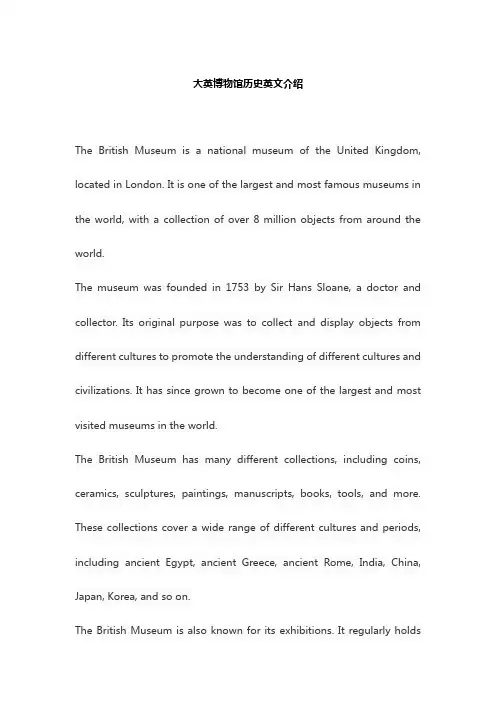
大英博物馆历史英文介绍The British Museum is a national museum of the United Kingdom, located in London. It is one of the largest and most famous museums in the world, with a collection of over 8 million objects from around the world.The museum was founded in 1753 by Sir Hans Sloane, a doctor and collector. Its original purpose was to collect and display objects from different cultures to promote the understanding of different cultures and civilizations. It has since grown to become one of the largest and most visited museums in the world.The British Museum has many different collections, including coins, ceramics, sculptures, paintings, manuscripts, books, tools, and more. These collections cover a wide range of different cultures and periods, including ancient Egypt, ancient Greece, ancient Rome, India, China, Japan, Korea, and so on.The British Museum is also known for its exhibitions. It regularly holdsexhibitions of different themes and cultures to showcase its collections and promote understanding of different cultures.In addition to its collections and exhibitions, the British Museum also provides a variety of educational programs and resources for people of all ages and interests. These include guided tours, lectures, workshops, and more.Overall, the British Museum is a museum that showcases global culture and history. It has a rich collection of artifacts and exhibitions, as well as various educational resources and activities, providing people with the opportunity to gain a deeper understanding of different cultures and histories.大英博物馆是英国的国家博物馆,位于伦敦。
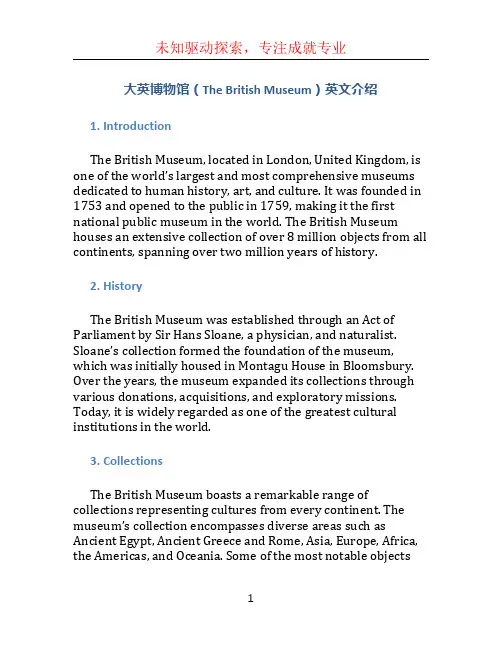
大英博物馆(The British Museum)英文介绍1. IntroductionThe British Museum, located in London, United Kingdom, is one of the world’s largest and most comprehensive museums dedicated to human history, art, and culture. It was founded in 1753 and opened to the public in 1759, making it the first national public museum in the world. The British Museum houses an extensive collection of over 8 million objects from all continents, spanning over two million years of history.2. HistoryThe British Museum was established through an Act of Parliament by Sir Hans Sloane, a physician, and naturalist. Sloane’s collection formed the foundation of the museum, which was initially housed in Montagu House in Bloomsbury. Over the years, the museum expanded its collections through various donations, acquisitions, and exploratory missions. Today, it is widely regarded as one of the greatest cultural institutions in the world.3. CollectionsThe British Museum boasts a remarkable range of collections representing cultures from every continent. The museum’s collection encompasses diverse areas such as Ancient Egypt, Ancient Greece and Rome, Asia, Europe, Africa, the Americas, and Oceania. Some of the most notable objectsinclude the Rosetta Stone, the Elgin Marbles, the Egyptian mummies, and the Sutton Hoo treasures.3.1 Ancient EgyptThe Egyptian collection at the British Museum is one of the largest and most comprehensive in the world. It includes ancient Egyptian artifacts like statues, tomb reliefs, and everyday objects. The collection also features famous mummies, including that of Cleopatra as well as stunning examples of ancient Egyptian jewelry and decorative arts.3.2 Ancient Greece and RomeThe museum’s collection of Ancient Greece and Rome includes classical sculptures, pottery, jewelry, and architectural fragments. The Elgin Marbles, which are part of this collection, are a group of classical Greek marble sculptures that once adorned the Parthenon in Athens.3.3 AsiaThe Asian collection at the British Museum is particularly renowned for its comprehensive range of Chinese, Japanese, Indian, and Islamic art. The collection includes ceramics, textiles, paintings, sculptures, and metalwork spanning thousands of years.3.4 EuropeThe European collection at the British Museum includes a wide range of art and artifacts from various Europeancivilizations. This collection includes medieval treasures, Renaissance paintings, and decorative arts from different European countries such as France, Italy, and Germany.3.5 Africa, the Americas, and OceaniaThe British Museum also houses a significant collection representing the cultures of Africa, the Americas, and Oceania. This collection includes masks, sculptures, textiles, and other artifacts that reflect the rich cultural heritage of these regions.4. Museum FacilitiesThe British Museum offers visitors a range of facilities to enhance their experience. These include:•Information Desks: Located at different points throughout the museum, these desks provide visitors with information, maps, and guidance.•Audio Guides: Visitors can rent audio guides that provide detailed commentary on various objects andexhibitions in the museum.•Cafes and Restaurants: The museum has several cafes and restaurants where visitors can enjoy a variety of food and beverages.•Shops: The British Museum has several shops offering a wide range of souvenirs, books, and unique gifts related to the museum’s collections.•Education and Events: The museum hosts a diverse range of educational programs, lectures, workshops, andspecial events for visitors of all ages.5. Visiting Information•Location: Great Russell Street, London, WC1B 3DG, United Kingdom•Opening Hours: The museum is open daily from 10 am to 5:30 pm. On Fridays, it is open until 8:30 pm.•Admission: Entry to the British Museum is free.However, charges may apply for special exhibitions.•Accessibility: The museum is fully accessible to individuals with disabilities. It offers wheelchair access,accessible restrooms, and facilities for the visually impaired.•Getting There: The museum is well-connected by public transportation. The nearest underground stationsare Tottenham Court Road and Holborn.6. ConclusionThe British Museum is a world-renowned institution that provides visitors with a unique opportunity to explore the diverse cultures and history of humanity. Its vast collection, spanning thousands of years, offers a fascinating insight into the achievements and artistic expressions of civilizations from around the world. Whether you are interested in ancient Egypt, classical Greece, or contemporary art, the British Museum has something to offer for everyone. A visit to this remarkablemuseum is a must for anyone with a love for history, culture, and art.。
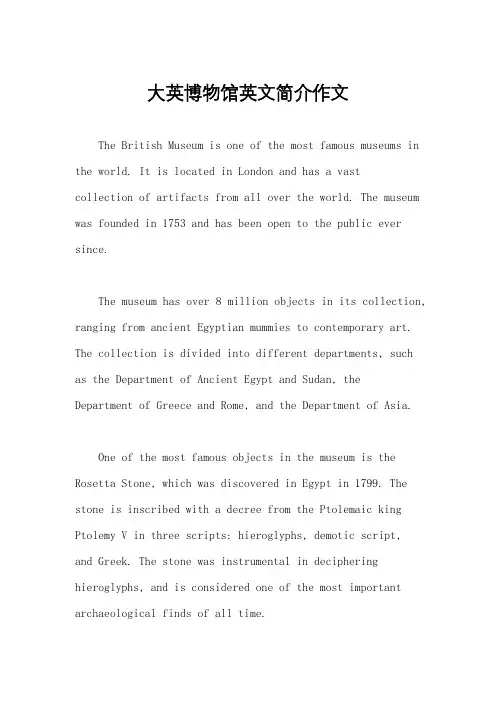
大英博物馆英文简介作文The British Museum is one of the most famous museums in the world. It is located in London and has a vastcollection of artifacts from all over the world. The museum was founded in 1753 and has been open to the public ever since.The museum has over 8 million objects in its collection, ranging from ancient Egyptian mummies to contemporary art. The collection is divided into different departments, such as the Department of Ancient Egypt and Sudan, the Department of Greece and Rome, and the Department of Asia.One of the most famous objects in the museum is the Rosetta Stone, which was discovered in Egypt in 1799. The stone is inscribed with a decree from the Ptolemaic king Ptolemy V in three scripts: hieroglyphs, demotic script,and Greek. The stone was instrumental in deciphering hieroglyphs, and is considered one of the most important archaeological finds of all time.The museum is also home to the Elgin Marbles, a collection of classical Greek marble sculptures that were originally part of the Parthenon temple in Athens. The sculptures were controversially removed from Greece in the early 19th century by Lord Elgin, and have been a source of dispute between Greece and the UK ever since.In addition to its permanent collection, the museum also hosts temporary exhibitions throughout the year. Recent exhibitions have included "Troy: Myth and Reality" and "Edvard Munch: Love and Angst."The British Museum is free to enter, although some temporary exhibitions may have an admission fee. It is open daily from 10am to 5:30pm, with extended hours on Fridays. The museum also has a range of cafes and shops, as well as a library and research facilities for scholars.。
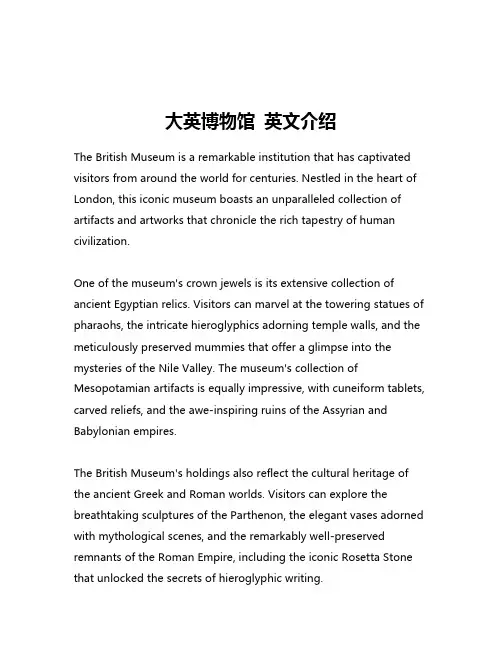
大英博物馆英文介绍The British Museum is a remarkable institution that has captivated visitors from around the world for centuries. Nestled in the heart of London, this iconic museum boasts an unparalleled collection of artifacts and artworks that chronicle the rich tapestry of human civilization.One of the museum's crown jewels is its extensive collection of ancient Egyptian relics. Visitors can marvel at the towering statues of pharaohs, the intricate hieroglyphics adorning temple walls, and the meticulously preserved mummies that offer a glimpse into the mysteries of the Nile Valley. The museum's collection of Mesopotamian artifacts is equally impressive, with cuneiform tablets, carved reliefs, and the awe-inspiring ruins of the Assyrian and Babylonian empires.The British Museum's holdings also reflect the cultural heritage of the ancient Greek and Roman worlds. Visitors can explore the breathtaking sculptures of the Parthenon, the elegant vases adorned with mythological scenes, and the remarkably well-preserved remnants of the Roman Empire, including the iconic Rosetta Stone that unlocked the secrets of hieroglyphic writing.Beyond its ancient treasures, the museum also boasts a rich collection of artifacts from the medieval and Renaissance periods. Visitors can marvel at the intricate illuminated manuscripts, the ornate religious relics, and the stunning paintings that capture the essence of these pivotal eras in European history.One of the museum's most captivating features is its extensive collection of artifacts from the ancient Americas. From the imposing stone carvings of the Aztecs and the Incas to the delicate textiles and ceramics of the Mesoamerican cultures, the museum's holdings offer a window into the fascinating civilizations that flourished in the New World.The British Museum's commitment to preserving and celebrating the diverse cultural heritage of humanity extends far beyond its physical walls. The institution's extensive digital resources, including online exhibitions and virtual tours, allow visitors from around the world to explore its vast collections from the comfort of their own homes.Moreover, the museum's dedication to education and research is truly commendable. Its team of curators, conservators, and scholars work tirelessly to unlock the stories behind the artifacts, sharing their knowledge with the public through lectures, workshops, and educational programs.The British Museum's influence extends far beyond its role as a custodian of the world's cultural treasures. It has become a hub for cultural exchange, hosting temporary exhibitions that showcase the artwork and artifacts of diverse global communities. These exhibitions not only promote cross-cultural understanding but also challenge visitors to broaden their perspectives and engage with new and unfamiliar narratives.In an age of globalization and increasing interconnectedness, the British Museum's role as a bridge between cultures has become more vital than ever. By preserving and celebrating the artistic and historical achievements of humanity, the museum reminds us of the richness and complexity of the human experience, inspiring us to embrace our shared heritage and to work towards a more just and equitable future.。
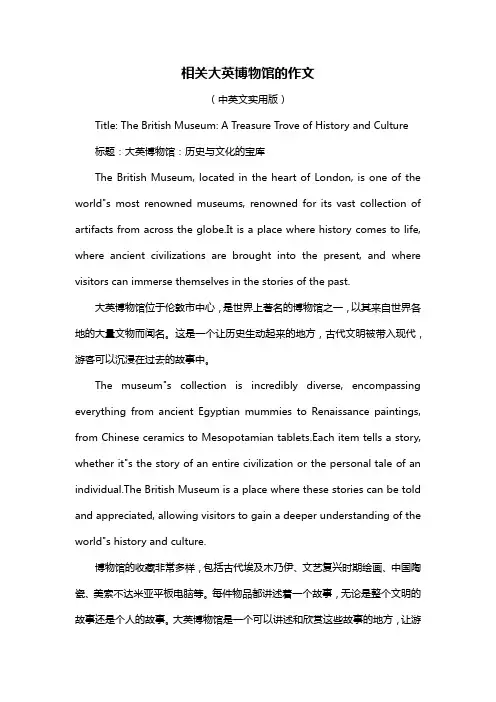
相关大英博物馆的作文(中英文实用版)Title: The British Museum: A Treasure Trove of History and Culture 标题:大英博物馆:历史与文化的宝库The British Museum, located in the heart of London, is one of the world"s most renowned museums, renowned for its vast collection of artifacts from across the globe.It is a place where history comes to life, where ancient civilizations are brought into the present, and where visitors can immerse themselves in the stories of the past.大英博物馆位于伦敦市中心,是世界上著名的博物馆之一,以其来自世界各地的大量文物而闻名。
这是一个让历史生动起来的地方,古代文明被带入现代,游客可以沉浸在过去的故事中。
The museum"s collection is incredibly diverse, encompassing everything from ancient Egyptian mummies to Renaissance paintings, from Chinese ceramics to Mesopotamian tablets.Each item tells a story, whether it"s the story of an entire civilization or the personal tale of an individual.The British Museum is a place where these stories can be told and appreciated, allowing visitors to gain a deeper understanding of the world"s history and culture.博物馆的收藏非常多样,包括古代埃及木乃伊、文艺复兴时期绘画、中国陶瓷、美索不达米亚平板电脑等。
博物馆全攻略:大英博物馆When the British Museum opened in 1753, it was the world’s first national public museum, free (as it still is) to all “studious and curious persons.” It contains a breathtaking collection of over 8 million objects that paint an interconnected portrait of the world’s cultures. But it also epitomizes the long British traditions of exploration, quirkiness and obsessive collecting. You could spend weeks here. But don’t worry; we’ll guide you through.大英博物馆于1753年对外开放,是世界上第一个国立公共博物馆,免费(至今仍然如此)对所有“勤奋与好奇的人”开放。
它的藏品达到惊人的800多万件,为多种世界文化描绘出一幅彼此相联的画卷。
但它也体现了英国长期以来探索、怪趣与收藏癖的悠久传统。
你可以在这里一连呆上几个星期。
但是不要担心:我们可以为你做个向导。
Five Must-Sees五个必看之处If you don’t have time to idly wander, start your visit with these collections.如果你没时间到处闲逛,那就从这些藏品开始吧。
THE KEY TO THE ANCIENT WORLD通往古代世界的钥匙The Egyptian Galleries | Room 4埃及馆| 4号展厅This long, spectacular gallery, stretching almost the length of the museum’s west side, houses sculptures and artifacts from about 3,000 years of ancient Egyptian civilization. It features spectacular busts, elaborately engraved sarcophagi and the museum’s most popular exhibit —the Rosetta Stone, dating from 196 B.C. and inscribed with near-identical texts in three scripts, which allowed linguists to develop an understanding of Egyptian hieroglyphs through comparison.这个长而壮观的展馆几乎贯穿整个博物馆西翼,藏有横跨3000年古埃及文明的雕塑与文物。
描写大英博物馆的英文英语作文The British Museum is one of the most famous and prestigious museums in the world, located in London, England. It was established in 1753 and has a vast collection of art and artifacts from all over the world, covering a period of over two million years of human history.The museum is housed in a beautiful neoclassical building and is renowned for its extensive and diverse collection, which includes ancient Egyptian mummies, Greek and Roman sculptures, and a wide range of artifacts from different civilizations across the globe. The museum also has a comprehensive collection of coins, medals, and decorative arts, as well as a vast library and archives.One of the most iconic pieces in the museum is the Rosetta Stone, which played a crucial role in deciphering ancient Egyptian hieroglyphs. Other notable exhibits include the Elgin Marbles, the Parthenon sculptures, and the Egyptian mummies. The museum also hosts temporary exhibitions and events, showcasing various themes and periods of history.The British Museum is not only a place for academic research and study, but also a popular tourist attraction, drawing millions of visitors from around the world each year. Its vast and diverse collection offers a unique opportunity for people to learn about different cultures and civilizations, and to gain a deeper understanding of our shared human history.In addition to its permanent collection, the museum also offers a range of educational programs and resources for schools and families, making it an invaluable resource for learning and exploration. The museum's website provides access to its collection, research, and educational resources, allowing people from all over the world to engage with its content.Overall, the British Museum is a treasure trove of human history and culture, offering a rich and immersive experience for visitors of all ages and backgrounds. Its commitment to research, education, and public engagement makes it a truly world-class institution.大英博物馆是世界上最著名和有声望的博物馆之一,位于英格兰伦敦。
博物馆全攻略:大英博物馆When the British Museum opened in 1753, it was the world’s first national public museum, free (as it still is) to all “studious and curious persons.”It contains a breathtaking collection of over 8 million objects that paint an interconnected portrait of the world’s cultures. But it also epitomizes the long British traditions of exploration, quirkiness and obsessive collecting. You could spend weeks here. But don’t worry; we’ll guide you through.大英博物馆于1753年对外开放,是世界上第一个国立公共博物馆,免费(至今仍然如此)对所有“勤奋与好奇的人”开放。
它的藏品达到惊人的800多万件,为多种世界文化描绘出一幅彼此相联的画卷。
但它也体现了英国长期以来探索、怪趣与收藏癖的悠久传统。
你可以在这里一连呆上几个星期。
但是不要担心:我们可以为你做个向导。
Five Must-Sees五个必看之处If you don’t have time to idly wander, start your visit with these collections.如果你没时间到处闲逛,那就从这些藏品开始吧。
THE KEY TO THE ANCIENT WORLD通往古代世界的钥匙The Egyptian Galleries | Room 4埃及馆| 4号展厅This long, spectacular gallery, stretching almost the length of the museum’s west side, houses sculptures and artifacts from about 3,000 years of ancient Egyptian civilization. It features spectacular busts, elaborately engraved sarcophagi and the museum’s most popular exhibit —the Rosetta Stone, dating from 196 B.C. and inscribed with near-identical texts in three scripts, which allowed linguists to develop an understanding of Egyptian hieroglyphs through comparison.这个长而壮观的展馆几乎贯穿整个博物馆西翼,藏有横跨3000年古埃及文明的雕塑与文物。
大英博物馆介绍英文The British Museum is one of the most iconic and prestigious museums in the world. It is located in London, England, and houses a vast collection of art, artifacts, and historical objects from all corners of the globe. 大英博物馆是世界上最具标志性和声誉的博物馆之一。
它位于英格兰的伦敦,收藏了来自全球各个角落的艺术品、文物和历史物品。
The museum was established in 1753 and has since become a major cultural institution, attracting millions of visitors each year. Its collection spans over two million years of human history, showcasing the diversity and richness of different civilizations. 该博物馆成立于1753年,自那时以来已成为一个重要的文化机构,每年吸引着数百万游客。
其收藏涵盖了两百万年的人类历史,展示了不同文明的多样性和丰富性。
One of the most famous exhibits at the British Museum is the Rosetta Stone, which played a crucial role in deciphering Egyptian hieroglyphics. Other highlights include the Elgin Marbles, the Egyptian mummies, and the Parthenon sculptures. 大英博物馆最著名的展品之一是罗塞塔石碑,它在解读埃及象形文字中起着至关重要的作用。
B r i t i s h M u s e u mThe British Museum is a museum of human history and culture in London. Its collections, which number more than seven million objects,are amongst the largest and most comprehensive in the world and originate from all continents, illustrating and documenting the story of human culture from its beginnings to the present.The British Museum was established in 1753, largely based on the collections of the physician and scientist Sir Hans Sloane. The museum first opened to the public on 15 January 1759 in Montagu House in Bloomsbury, on the site of the current museum building. Its expansion over the following two and a half centuries was largely a result of an expanding British colonial footprint and has resulted in the creation of several branch institutions, the first being the British Museum (Natural History) in South Kensington in 1887. Some objects in the collection, most notably the Elgin Marbles from the Parthenon, are the objects of intense controversy and of calls for restitution to their countries of origin.Until 1997, when the British Library (previously centred on the Round Reading Room) moved to a new site, the British Museum was unique in that it housed both a national museum of antiquities and a national libraryin the same building. The museum is a non-departmental public body sponsored by the Department for Culture, Media and Sport, and as with all other national museums in the United Kingdom it charges no admission fee. Since 2002 the director of the museum has been Neil MacGregor.HistorySir Hans Sloane, founder of the British MuseumAlthough principally a museum of cultural art objects and antiquities today, the British Museum was founded as a "universal museum". Its foundations lie in the will of the physician and naturalist Sir Hans Sloane (1660–1753). During the course of his lifetime Sloane gathered an enviable collection of curiosities and, not wishing to see his collection broken up after death, he bequeathed it to King George II, for the nation, for the princely sum of £20,000.At that time, Sloane’s collection consisted of around 71,000 objects of all kinds[8] including some 40,000 printed books, 7,000 manuscripts, extensive natural history specimens including 337 volumes of dried plants, prints and drawings including those by Albrecht Dürer and antiquities from Egypt, Greece, Rome, the Ancient Near and Far East and the Americas.Foundation (1753)On 7 June 1753, King George II gave his formal assent to the Act of Parliament which established the British Museum.The Foundation Act, added two other libraries to the Sloane collection. The Cottonian Library, assembled by Sir Robert Cotton, dated back to Elizabethan times and the Harleian library, the collection of the Earls of Oxford. They were joined in 1757 by the Royal Library, assembled by various British monarchs. Together these four "foundation collections" included many of the most treasured books now in the British Library including the Lindisfarne Gospels and the sole surviving copy of Beowulf.The British Museum was the first of a new kind of museum – national, belonging to neither church nor king, freely open to the public and aiming to collect everything. Sloane's collection, whilst including a vast miscellany of objects, tended to reflect his scientific interests. The addition of the Cotton and Harley manuscripts introduced a literary and antiquarian element and meant that the British Museum now became both national museum and library.大英博物馆(British Museum)又称不列颠博物馆,是一位于英国伦敦的综合博物馆,也是世界上规模最大、最着名的博物馆之一,成立于1753年。
目前博物馆拥有藏品1300多万件。
由于空间的限制,目前还有大批藏品未能公开展出。
博物馆在1759年1月15日起正式对公众开放。
历史:大英博物馆的渊源最早可追溯到1753年。
汉斯·斯隆(Hans Sloane1660-1753年)爵士是当时的一位着名收藏家,1753年他去世后遗留下来的个人藏品达1700件,还有大批植物标本及书籍、手稿。
根据他的遗嘱,所有藏品都捐赠给国家。
这些藏品最后被交给了英国国会。
在通过公众募款筹集建筑博物馆的资金后,大英博物馆最终于1759年1月15日在伦敦市区附近的蒙塔古大楼(Montague Building)成立并对公众开放。
博物馆在开放后通过英国人在各地的各种活动攫取了大批珍贵藏品,早期的大英博物馆倾向于收集自然历史标本,但也有大量文物、书籍,因此吸引了大批参观者。
到了19世纪初,蒙塔古大楼已经显得不敷使用了。
于是1824年博物馆决定在蒙塔古大楼北面建造一座新馆,并在1840年代完成,旧蒙塔古大楼不久后便被拆除。
新馆建成后不久又在院子里建了对公众开放的圆形阅览室。
由于空间的限制,1880年大英博物馆将自然历史标本与考古文物分离,大英博物馆专门收集考古文物。
1900年,博物馆再次重新划分,将书籍、手稿等内容分离组成新的大英图书馆。
简介:大中庭(Great Court)位于大英博物馆中心,于2000年12月建成开放,目前是欧洲最大的有顶广场。
广场的顶部是用2436块三角形的玻璃片组成的。
广场中央为大英博物馆的阅览室,对公众开放。
大英博物馆历史上除了1972年的几个月外,一直都是免费对公众开放。
2002年博物馆面临了严重的财政危机,由于馆员抗议裁员,博物馆甚至被迫关闭了几天。
几个星期后,一个希腊雕像失窃,主要原因是保安人员的缺乏。
大英博物馆阅览室原来属于大英图书馆,但图书馆阅览室已经搬到了图书馆大楼,现在为博物馆的阅览室。
大英博物馆目前分为10个分馆:古近东馆、硬币和纪念币馆、埃及馆、民族馆、希腊和罗马馆、日本馆、东方馆、史前及欧洲馆、版画和素描馆以及西亚馆。